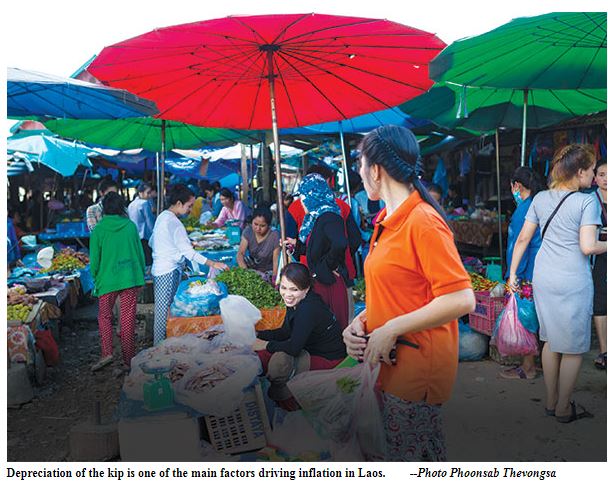Laos: Govt struggles to regulate currency exchange rates
The continuing depreciation of the kip is creating a major roadblock in the government’s efforts to rein in inflation, especially as one third of the goods used to calculate price rises are imported.
The kip has fallen in value by 19.44 percent against the US dollar and by 18.02 percent against the Thai baht over the past nine months, according to the government.
Meanwhile the US$/kip parallel market exchange rate exceeded the official rate by 12.33 percent and the Thai baht/kip exchange rate by 4.27 percent.
Governor of the Bank of the Lao PDR (BOL), Dr Bounleua Sinxayvoravong, told the National Assembly recently that the weak kip is fundamental in driving inflation, which was recorded at 38.46 percent in November.
The central bank governor said collaboration between the sectors involved in currency regulation was not sufficiently comprehensive, meaning that most of the foreign currency earned from exports and foreign investment was not entering the banking system.
At a news conference held in May this year, the Bank of the Lao PDR reported that only 33 percent of the total income earned from exports entered the economy through the banking system in the first four months of this year, with the rest deposited offshore.
Another issue is that actual foreign investment inflows through the banking system are much lower than the agreed value of investments.
Another factor contributing to the weak kip is the US central bank’s hiking of interest rates as it wrestles to curb fast rising prices.
The Federal Reserve was quoted by the BBC recently as saying that it was raising its key interest rate by 0.75 percentage points, lifting it to its highest rate since early 2008.
Last month, the Thai baht rose to its strongest level in almost three months after China eased some of its quarantine rules for visitors. A strong baht could result in an increase in the price of goods imported from Thailand.
The Bank of the Lao PDR says it will not only ensure that more foreign currency sourced from exports and investment enters the banking system, but will also do more to regulate exchange rates.
In September 2021, some 419 out of the 550 money exchange units were tied to commercial banks and have since operated under the authorisation of banks. This was done in a bid to tackle the difference in exchange rates between commercial banks and money-changing outlets.
In addition, the stricter regulation of exchange rates has resulted in 300 money changing units possibly having their licences revoked.
In the future, the operations of money changing units could be limited to locations at banks, hotels, airports and border crossings, Dr Bounleua said.
He explained that Laos is facing challenges in regulating currency exchange rates because the country imports substantially. Secondly, many Lao people keep foreign currencies in reserve and use these currencies for trade rather than kip.
Source: https://www.vientianetimes.org.la/freeContent/FreeConten2022_Govt243.php


 Thailand
Thailand




